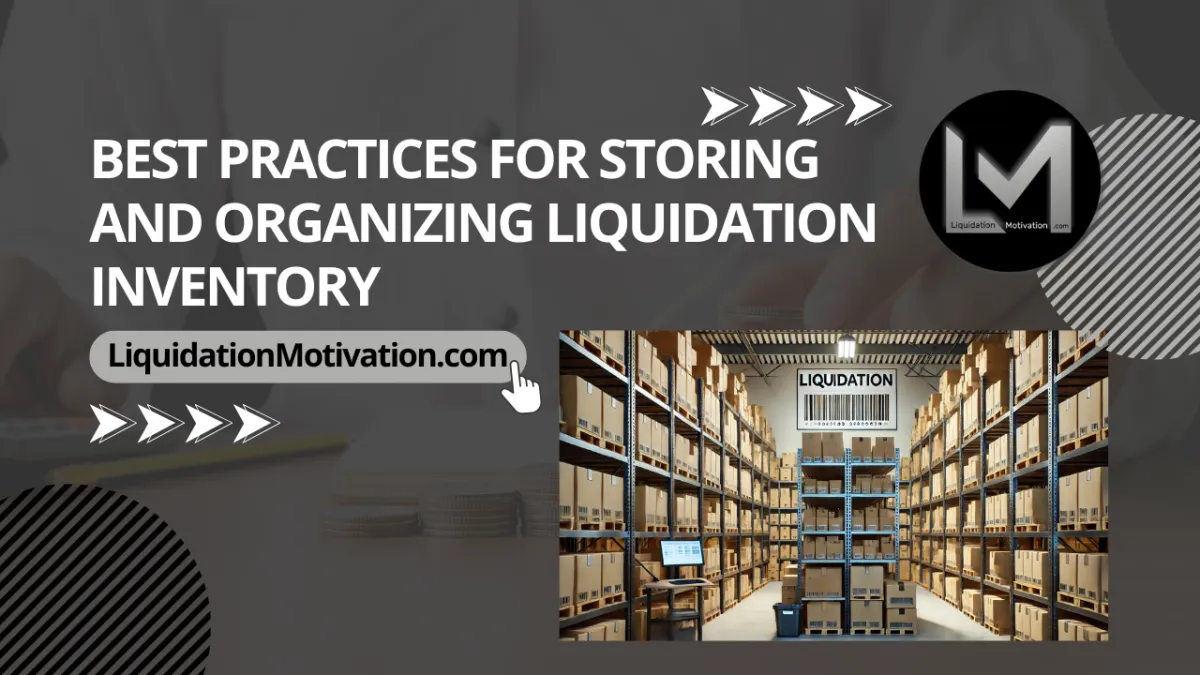
Best Practices for Storing and Organizing Liquidation Inventory
Best Practices for Storing and Organizing Liquidation Inventory
Buying liquidation inventory is an exciting way to stock up on products at unbeatable prices, but without the right storage and organization strategy, your investment can quickly turn into a cluttered mess. Properly managing your liquidation inventory ensures you maximize profits, reduce loss, and streamline your reselling operation. Whether you run a storefront, an e-commerce business, or a flea market booth, here’s how to keep your liquidation inventory organized and working for you.

1. Designate a Dedicated Storage Space
The first step in managing your liquidation inventory is setting up a dedicated storage space. Whether it’s a spare room, garage, warehouse, or rented storage unit, having a specific location for your inventory keeps everything in order.
Keep your storage space clean and free of obstructions.
Ensure there’s enough room for easy movement and access to products.
Use shelves, racks, and bins to make the most of vertical and horizontal space.
2. Sort and Categorize Inventory Immediately
When you receive a new shipment of liquidation inventory, sort and categorize it right away.
By Product Type: Group similar items together, such as electronics, home goods, or apparel.
By Condition: Separate new, used, damaged, and refurbished items.
By Sales Channel: If you sell on multiple platforms (eBay, Amazon, local markets), organize inventory by where it will be listed.
This system prevents confusion and makes it easier to locate items when they sell.
3. Label Everything Clearly
Clear labeling is essential to maintaining an organized inventory system. Every box, bin, and shelf should be labeled with relevant details, such as:
SKU or item number
Product description
Date received
Sales channel (if applicable)
Using a barcode or QR code system can make tracking inventory even more efficient, reducing the chances of misplacing items.
4. Implement a First-In, First-Out (FIFO) System
To prevent inventory from sitting too long and losing value, use the FIFO method:
Place newly acquired inventory behind older stock.
Sell older items first to ensure products don’t become outdated or damaged.
Regularly audit your inventory to identify slow-moving items and adjust pricing accordingly.
5. Use Inventory Management Software
If you’re serious about scaling your liquidation reselling business, consider using inventory management software. These tools help you track stock levels, sales trends, and profit margins more effectively. Popular options include:
QuickBooks Commerce
Zoho Inventory
Inventory Lab
Spreadsheet-based tracking (for small-scale sellers)
Automating inventory tracking helps prevent overselling and ensures you always know what’s in stock.

6. Create a System for Returns and Damaged Items
Not everything in a liquidation lot will be in perfect condition. Establish a system for handling returns and damaged items:
Have a designated area for damaged or defective items.
Determine whether items can be repaired, resold at a discount, or written off.
List any items that can still be sold in the appropriate condition category (e.g., “Used – Good” or “For Parts”).
7. Maintain an Organized Workspace
A cluttered workspace slows you down. Keep your packing and shipping station separate from your storage area and ensure you have all necessary supplies within reach, including:
Boxes, bubble wrap, and packing tape
Shipping labels and printers
Weighing scales for accurate postage
A well-organized workspace increases efficiency and reduces order processing time.
8. Regularly Audit Your Inventory
Set a schedule to conduct regular inventory audits to ensure accuracy. Whether weekly, biweekly, or monthly, checking stock levels and updating records can help prevent lost sales due to inventory discrepancies.
9. Plan for Growth
As your liquidation business expands, so will your storage needs. Plan for growth by:
Upgrading storage solutions (shelves, bins, warehouse space)
Hiring staff to assist with sorting and shipping
Streamlining processes to handle larger order volumes efficiently
10. Stay Flexible and Adapt
Market trends change, and so will your inventory needs. Be prepared to reorganize and adjust your system as you scale. By staying proactive and maintaining a well-structured inventory process, you’ll be able to keep your business running smoothly while maximizing profits.

Final Thoughts
A well-organized liquidation inventory isn’t just about neatness—it’s about efficiency, profitability, and growth. Implementing these best practices will help you stay on top of your stock, reduce losses, and make your reselling business more successful. Whether you’re selling through e-commerce, a physical store, or flea markets, having a solid inventory system ensures you get the most out of your liquidation purchases.
For more tips on sourcing and selling liquidation merchandise, stay connected with Liquidation Motivation—we’re here to help you succeed!
Happy bidding!
The Liquidation Motivation Team
Lake Wales, Florida
Lake Wales Florida Looking for bulk deals? Click here to send us a text: (315) 778-8744!